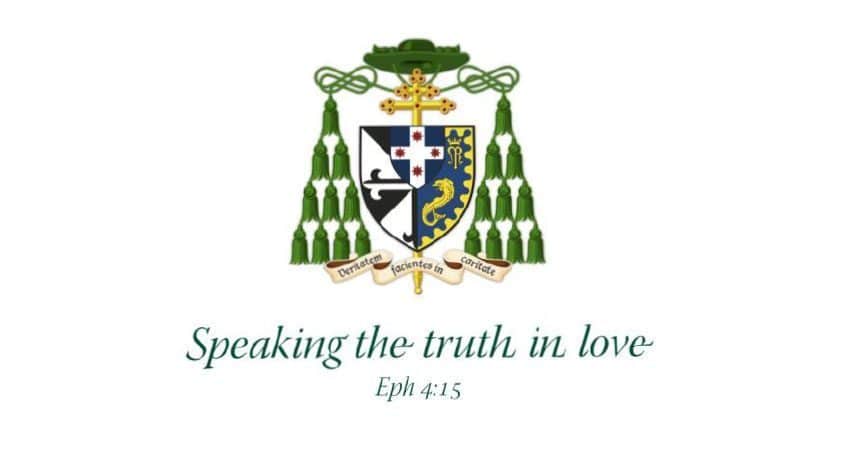HOMILY FOR MASS OF THE DEDICATION OF A CHURCH

St. Joseph’s Church, Rosebery
“You are the rock on which I will build my Church,” Jesus says to Peter this morning (Mt 16:13-19). “You are God’s building… the temple in which the spirit dwells,” St. Paul says to the Corinthians as well (1 Cor 3:9-17). Why, then, do we bother to build churches for God of dead stones when each of us is His living building?
Well, one reason is that, as both Jesus and Paul make clear, none of us is the whole building. In Jesus’ Church, Peter is the rock foundation, Jesus Himself the τέκτων or Builder (the profession his Dad and your patron: Mk 6:3), the apostles are the pillars (cf. Eph 2:20; Rev 21:14) and the faithful the stones. In Paul’s version Christ is the foundation, the ἀρχιτέκτων or Master Builder, those who went after him were the builders and our generation only the present bricks: in due course we’ll be replaced by those stones and decorations that are the next generation.
Okay, but why can’t we ‘living stones’ just pray at home or wherever we are? Of course we can—and should. But when Paul says ‘you are God’s building’, he’s not talking in the singular: he’s speaking to the Corinthian Christians, all of us. Likewise Jesus means the whole Christian community when he talks of ‘my Church’. But you don’t get a whole community together for worship without a building—especially during a La Nina. The physical building may be a place for private prayer, sure, but its principal rationale is public worship and community-building: it’s for people plural. We get that more than ever after four months of COVID lockdown kept us apart.
Our first reading this morning makes it clear that the dedication of a church is a big deal (2 Chr 5:6-11, 13-6:2). Rebuilt in 515 BC after the first Temple had been destroyed by the Babylonians (in 586 BC), the second one was consecrated by Ezra the priest. We’re told he read from the Bible and preached from dawn to midday, by which time all the people were weeping whether because they were so moved or so exhausted! The building was a major monument and meeting place for that neighbourhood, city and nation, and so, as well as Archbishop Ezra, Rt. Hon. Nehemiah, a high official of the Persian Court, was there as is our Lord Mayor this morning.
There’s more. Paul doesn’t just say we are God’s building, synagogue, parish church; he says we are also His Temple or cathedral. The Temple was, of course, the place where the God of Israel was said to be most intensely present; where Israel’s most sacred scrolls, vessels and vestments were stored; where the sacrifices and offerings were made; and where the Ark of the Covenant was housed. The ark was a tabernacle or safebox for the tablets of the ten commandments, for Aaron’s rod and for a pot of the manna that fell from heaven to feed the Israelites in the desert. It was designed to be carried around on long poles like a sedan chair and so also called God’s Mercy Seat.
Nowadays Catholics speak of the tabernacle as the lockbox for the Eucharist—our manna from heaven—but the Latin word tabernaculum actually means ‘tent’ rather than safe, which is why our tabernacles are commonly veiled. So, although our physical church stays put, we living temples can pack up our tents and carry the ark outside, taking God to the world within us. But like the ark we always ‘come home’ in the end to the Temple. Jesus identified Himself with the Temple (Jn 2:19-20) and His disciples as the new congregation, He also frequented the physical Temple, teaching there “day after day”, healing the sick, paying the temple tax and famously doing His own renovation job, cleansing the Temple (Mt 4:5; 17:24-25; 21:12-15,23; 24:1; 26:55). So the building was a central location for His ministry and He still invites us, not into a house so much as His Father’s home, for home is where the heart is.
So the church we dedicate today is no mere multipurpose room, museum for artefacts, or dining room for a special meal. No: this is the place to praise, bless and preach; to sacrifice, intercede and thank; to hymn, bow and genuflect; to honour, consecrate and commune; to christen, absolve and commission. Here the most extraordinary things occur: human babies are changed into children of God, bread and wine into Christ’s body and blood, couples into spouses, singles into priests and religious, sinners into saints, and the dead sent on their way to God. Such exceptional events deserve an exceptional place.
Of course, the People of God are more truly the Church than the chapels they build; the community of Sydney City South far more than this building. God built His Church on Jesus, and Jesus on Peter, not on a concrete slab. Ultimately, our dedication of this church today is an invitation to each of us to assume our identity as members of God’s household while on earth and as destined to heaven in the end. As Vatican II put it: “This temple, symbolised in places of worship built out of stone, is praised by the Fathers and, not without reason, is compared in the liturgy to the Holy City, the New Jerusalem. As living stones we here on earth are built into it.”[1] And we try to bring others in too.
So whether you are yourself a little chapel or a grand basilica, a gothic wonder or a modernist construct, you know that, like the building we dedicate today, you need periodic spiritual renovation. So you witness today’s Rite ask God to reconsecrate you also. As you witness natural materials made into a supernatural home, let the Holy Spirit renew you as His temple, so like this place dedicated for divine service, your very life may be a liturgy also!
INTRODUCTION to MASS of the DEDICATION of a CHURCH
St. Joseph’s Church, Rosebery
Welcome to St Joseph’s Church, Rosebery, for the Solemn Mass for the Dedication of a Church. It seems only yesterday that I was here installing Fr Paul as your new parish priest: he must have been working the building hard to have broken it already!
In all seriousness, you may wonder why, after 94 years, the church is only now being consecrated. The reason is that, under canon law at the time, a church could not be consecrated until it had been fully paid off; the Church didn’t want any bank foreclosing and then owning a consecrated building, or selling it to who knows whom to do who knows what! What’s more, the ceremonies around the consecration of a church used to take all day and were not for the faint-hearted! So when this school-church was opened in 1927 it was blessed in this very week of December by Archbishop Michael Kelly. But by the time all the debt on the church, school and convent had been paid off, people had forgotten that it had never been consecrated!
Recently this parish has been very active in giving the church a facelift: you have a new altar, lectern, sanctuary, new artwork, a remodelled baptistry and confessional, a 24-hour chapel, as well as renewed carpets and painting, the renovated parish office and community space, the spanking new preschool and long day care centre, and preparations have begun for resurfacing the carpark and constructing a primary school. After all this Fr Paul petitioned for the church to be consecrated at last. You certainly deserve it after giving yourselves so generously to the beautification of this house of God and to extending your arms wide to the local community in these new ways. You will notice the consecration candles around the walls which are one of the signs that the deed has been done!
The ceremony of the dedication of a church is one of the most ancient and beautiful of the Catholic Church—one few Catholics ever witness. Like the stages of initiation of a new Christian, you’ll witness the ‘Baptism’ of the church and especially the altar with holy water, its being ‘catechised’ by the readings and homily from the ambo, its ‘Confirmation’ with sacred Chrism rubbed at certain points around the walls and almost massaged into the altar, then being dressed in white like a newly baptised baby and given a candle (and a fiery one at that!), followed by receiving the kiss of peace and celebrating its first ‘Holy Communion’. So it is a chance for each of us to reflect on our own journey of faith as a Christian.
Concelebrating with me today is your parish priest, Fr Paul Smithers, to whom I pay tribute for directing these works, but also for reuniting the three communities of Rosebery, Waterloo and Redfern as the new Parish of Sydney City South. I also acknowledge our distinguished guests: Rt Hon. Clr Clover Moore, Lord Mayor of Sydney; from the Archdiocese of Sydney Mr Chris Meney, Chancellor, Mr Michael Digges, Executive Director (Admin & Finance) and Mr Michael Moore, Financial Controller; Ms Marg Holles, Principal of Our Lady of Mount Carmel Primary School Waterloo and Mr Bernard Ryan, Principal of the forthcoming St Joseph’s Primary School Rosebery; and Ms Franceyn O’Connor, Director of Sydney Catholic Early Learning Services. My particular congratulations to the architects and builders of the early learning centre and those who made all the works happen. To everyone present: a very warm welcome to you all!
[1] Vatican council II, Lumen Gentium, 6

